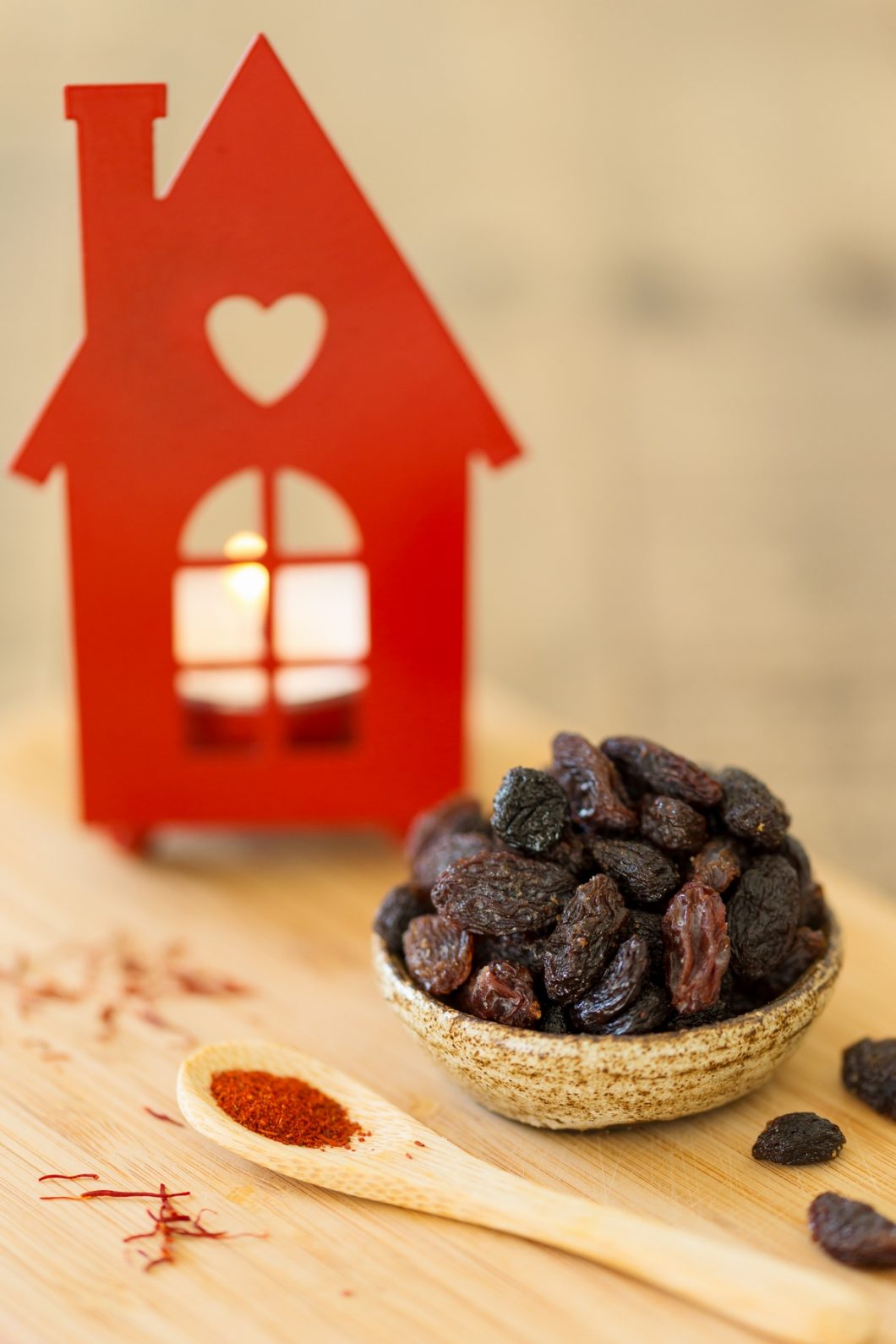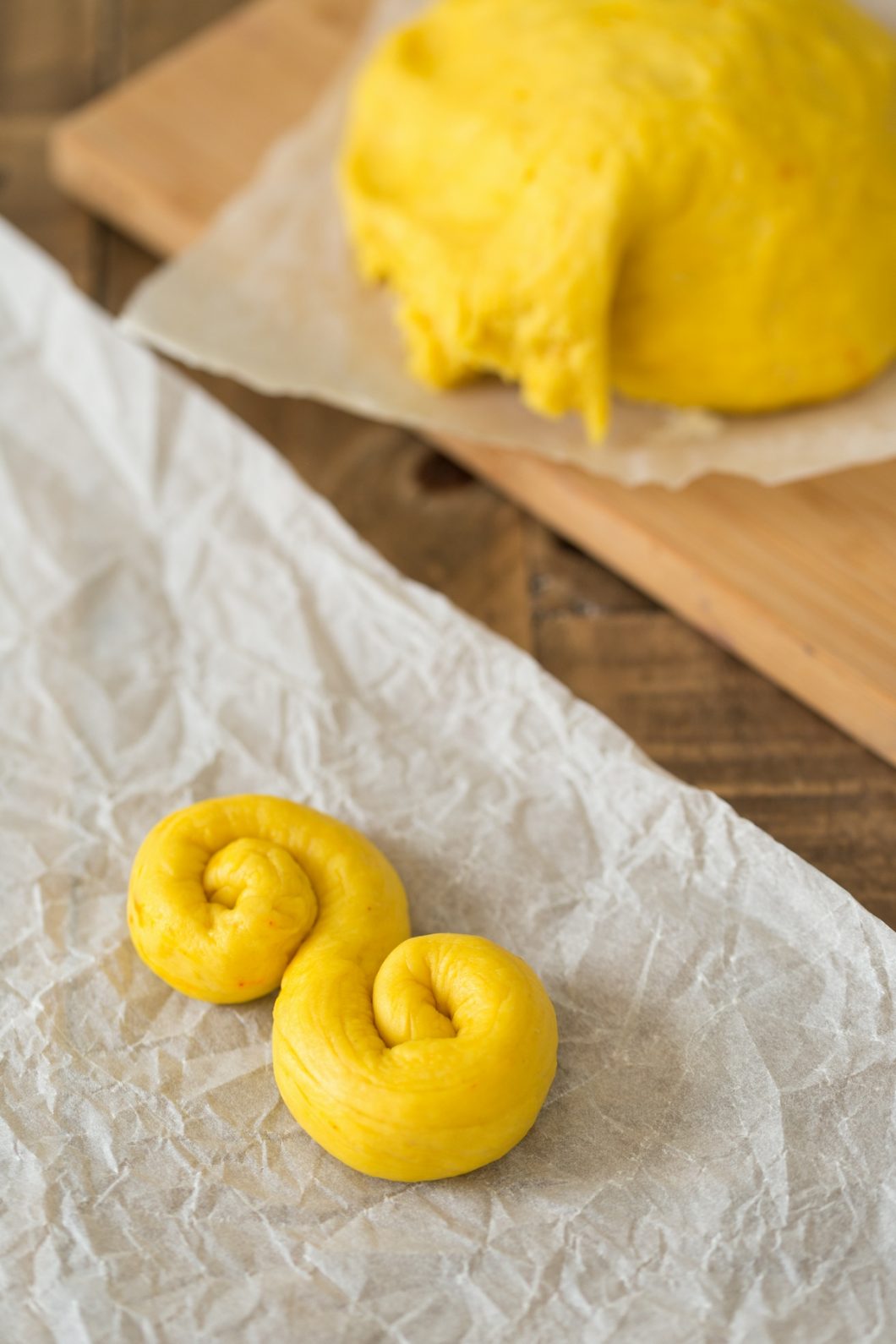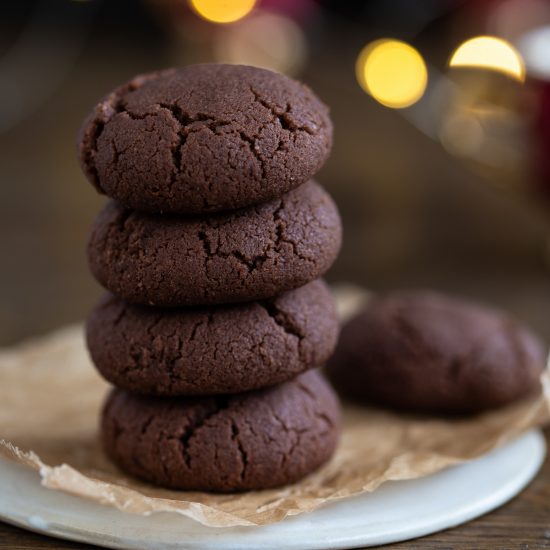Swedish saffron buns are a traditional recipe enjoyed around St. Lucy’s day in Sweden. Known in Swedish as lussekatter or lussebullar, they are semi-sweet yeast buns flavoured with ground saffron. Saffron gives these buns both their distinctive flavour and yellow colour. They are usually topped with 2 raisins.

What are the Swedish saffron buns
Lussekatter – or lussebullar – are a very popular baked good widely enjoyed in Sweden and Norway throughout the month of December. You can recognize them by their bright yellow colour and reversed S-shape. Unlike other traditional sweet breads like the cinnamon buns or cardamom rolls, the saffron buns are strictly seasonal. They usually start appearing in bakeries around mid-November, but the actual day when you’re supposed to eat them is December 13, Saint Lucy’s day.
The Swedish saffron buns are delicious. You can’t possibly be eating them only once a year. So despite being connected to Saint Lucy’s day, lussekatter are really a thing thoughout Advent. During the month of December every store in Sweden sells saffron. It comes in small packets that weigh 0,5 g (1/4 of a teaspoon, more or less). It’s obviously meant for all the home bakers that spend their weekends making saffron buns. But even those who do not bake can enjoy plenty of lussekatter as every bakery has them on sale.
Lussekatter recipe
Traditional Swedish fika recipes have huge yields and call for huge amounts of ingredients. This recipe has been adapted to make the recipe quicker and with a smaller yield. This is the recipe I was using with my pupils on the last week before the Christmas break when I was a Home Economics teacher.
Lussekatter freeze great, so if you feel like doubling things up, do it and save leftovers in the freezer for later! To do that, just jump to the recipe card below and toggle to adjust the yield you desire. Read on for step by step photos and instructions. Here’s what you will need:
- Butter
- Milk
- Fresh yeast
- Sugar
- Saffron
- Flour
- Egg
- Raisins
- A pinch of salt.

How to make saffron buns
- Combine the butter and milk in a small saucepan, set over low heat and stir until melted. Remove from heat, stir in the saffron and let the mixture cool to lukewarm. Then crumble the fresh yeast and stir it in.
- In a bowl, combine the flour, sugar and salt. Pour in the yeast mixture and stir with a spatula until the dough starts coming together. Knead it until you get a homogeneous ball, then cover and leave to rest for 40 minutes. The dough should feel very soft but not sticky, adjust the amount of flour if it’s too sticky to handle.
- When 40 minutes have passed, take about 1/6 of dough and roll it into a sausage. Swirl both ends to create the reversed S-shape and place the buns on an oven tray lined with baking paper. The saffron buns will grow some more as they bake, so space them out to allow for that. Let proof for 20 min.
- Lightly beat an egg and brush every bun with eggwash. Lastly, press a raisin into each swirl. Bake in the preheated oven at 250°C (480°F) for 6-7 minutes. You can see that once baked they look more swollen and have a golden hue.
Top tips and substitutions
To make your saffron buns dairy-free substitute the butter for margarine and the milk for your favourite plant-based alternative. I have used oat milk many times and I’m always very pleased with the result.
To make them vegan, do the same substitutions in the dough as mentioned above and instead of using eggwash, brush the buns with plant-based milk before baking them.
Traditional lussekatter should fit in one hand (see picture below) or be just slightly larger than that. You can choose to make them as smaller bite-size versions by dividing the dough into 12 parts and rolling each sausage to about as thin as a pencil. This is how we used to make them at school, because when they are so small baking time reduces to 5 minutes tops. Make them just before dinner and let proof in the fridge. Let them come to room temperature as the oven comes to temperature and in 5 minutes you will be serving fragrant saffron buns straight from the oven! It’s not a bad way to end a meal. Or start a day!

A little background story
St. Lucy’s day is known in Scandinavia as Sankta Lucia. It is an important festivity both in Sweden and Norway. Although seemingly a Christian festivity, its roots are pre-Christian and linked to winter solstice celebrations. The lack of sunlight is quite a big feature of the Scandinavian winter. Through November and December the days get shorter and shorter. The culmination of winter darkness happens on the winter solstice. Despite being the shortest day of the year – and the longest night – the winter solstice also means that the days from now on will only get longer.
The end of darkness has been celebrated long before Christianity made it to Scandinavia. In the older days it was traditionally connected to a female demon named Lussi. On the longest night of the year Lussi would set off on a Wild Hunt punishing those who had not finished work before Yule. Lussi was particularly frightful to children, as she was said to capture those who misbehaved.
When Christian festivities came to substitute Pagan ones, Lussi was juxtaposed with Lucia. Lucia was a young girl from Siracusa, Italy. Betrothed to a Pagan man, she refused to marry him and devoted her life to Christ instead. Tortured and killed for her belief, she died a martyr and was later canonized. Her name derives from the Latin lux, light, and the saint is known as the bearer of light. A very fitting quality for a saint celebrated on the longest night of the year. And an interesting parallel with Lussi, who also had such a similar name.
Swedish winter perks
Longing to taste the original stuff in Sweden but scared of the shortage of daylight hours? No worries! Winter is a wonderful time to visit Sweden! In fact, there are all sorts of adventures you can have only in winter. Like getting to taste the Swedish saffron buns. Or:
- Ice skating on frozen lakes, which is as cool as it sounds!
- Visiting an old-fashioned Christmas market at a UNESCO world Heritage Site.
- Get a taste of Julbord, traditional Christmas dining at a ski resort.
Not to mention the fact that it was in Stockholm in winter that I fell in love with my husband. Did you ever visit Sweden in winter? Do you love it as much as I do? Let me know in the comments and enjoy some homemade lussekatter!
This recipe was originally published in December 2018 and has been updated in November 2020 with new pictures and better wording.
Swedish saffron buns
Equipment
- Saucepan
- Spatula
- Measuring bowl
- Kitchen scale
- Baking sheet
Ingredients
- 30 g butter
- 100 ml milk
- 10 g fresh yeast
- 25 g sugar
- 0,1 tsp saffron ground
- 160 g flour
- 1 egg
- 12 raisins
- pinch of salt
Instructions
- Combine butter and milk in a small saucepan, set over low heat and stir until melted. Remove from the heat, stir in the saffron and let the mixture cool to lukewarm.
- When cooled, crush the fresh yeast into the milk mixture and stir to combine.
- Combine flour, sugar and salt in a bowl. Pour in yeast mixture and stir in with a spatula until it starts coming together, then knead until homogeneous. Form into a ball and cover with cling film. Let rest for 40 minutes.
- After 40 minutes, take about 1/6 of the dough and roll it into a sausage. Swirl both ends to create a reversed S-shape. Repeat and place each saffron bun on an oven tray lined with baking paper. Leave enough room for the buns to grow as they bake. Proof for 20 minutes.
- Lightly beat the egg and brush every bun with eggwash. Press a raisin into each swirl. Bake in the preheated oven at 250°C (480°F) for 6-7 minutes.
Notes













I love the story behind Lussekatte. Such pretty photos too! Thank you for sharing.
Thanks! Happy St. Lucy’s day!
I love learning about traditions like this. It’s a welcome reminder of how connected we all are culturally, a Sicilian child celebrated in Scandinavia, pagan and Christian elements mixing. And well done for making it snow on your page, I wish I had those IT skills!
Thank you, I totally agree with you. Contemporary culture is the result of many layers of past cultures overlapping and that is so interesting to analyse.
As for the snow, it is a free feature that can be enabled on any WordPress website. I set it up last year and I don’t remember how to do it but it’s one click in the settings. Just Google something like “snow on wordpress” and it should explain how to get that on your blog too!
Last year one of my copassenger in a train to kiruna shared this homemade saffron bread with me along with the story… Liked both
Must have been quite a cool experience hearing this story on the Arctic Circle train 😀 glad you liked the bun!
Of course it was pre Christmas in Sweden
And yeah, they’re impossible to find at a different time of the year!
These little buns look so cute!
Thank you 🙂
Those Swedish saffron buns look delicious and they’re so perfectly bite-sized I bet they’d disappear in minutes!
Yeah, compared to the original size, my buns are really tiny and perfect to just binge eat 😀
The Lussekatter look so good! I’d love to grab one of them right off that plate! 🙂
What a fascinating story behind these Swedish buns too!
Thank you 🙂 I love the tradition and how it just stuck in the culture over time and made two religions merge.
I can remember reading about the festival of light when I was a kid – Lussekatter look delicious – I love the idea of saffron-scented buns. Delicious!
This is so cool that you had read about this. Before I went to Norway for the first time I had no idea about this tradition. But when your winters are mostly made of darkness you can really understand the importance of such a festivity.